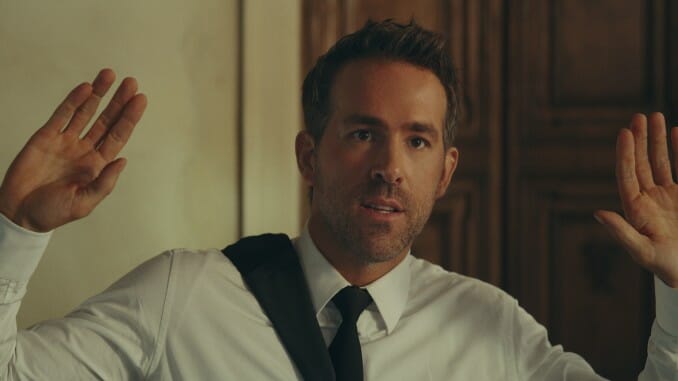Red Notice Is Bad for Hollywood, and Probably Humanity

For over a century now, the wheel of Hollywood has been continuously cranked by charisma. In the ‘30s and ‘40s, audiences lined up to watch Jimmy Stewart, Cary Grant and Katharine Hepburn, who could dazzle with even the most drab material. More recently, actors like Leonardo DiCaprio, Brad Pitt and Jennifer Lawrence brought masses to the theaters with the snap of their fingers. So what happens, then, when Hollywood’s marquee trio has the combined charisma of a wet paper towel?
This question is inadvertently posed by Red Notice, Netflix’s latest blockbuster, which is ripe with CGI and plays like it was written by one of those AI-trained bots—with this particular one having been fed hundreds of hours of soulless, money-wasting heist flicks. The film follows FBI criminal profiler John Hartley (Dwayne Johnson), as he attempts to catch one of the world’s leading art thieves, Nolan Booth (Ryan Reynolds), who is on a mission to steal Cleopatra’s mythic sparkling eggs. But the two get outsmarted by femme fatale art thief The Bishop (Gal Gadot) and end up in prison while she attempts to snag the eggs for herself. Where does that leave the duo? They’ve got to break out of prison and take the relics for themselves, of course.
Red Notice is framed as a mash-up homage to beloved capers and spy films—National Treasure and the films of James Bond and Indiana Jones. Of course, a large part of what’s so special about the aforementioned films is the sheer force of their collective star power. The iconic, smooth-talking, tux-wearing James Bond, for example, demands an almost aggressive charisma (try to take your eyes off of Sean Connery for more than two seconds, I dare you) as do his so-called Bond girls (Eva Green, I’m looking at you). The same is true for the rugged, adventurous Indiana Jones and even National Treasure’s Declaration-of-Independence-wielding Benjamin Franklin Gates (Nicolas Cage). That new blockbusters need to comprise star-power that will do enough heavy lifting to make up for cliched dialogue and derivative storylines is a pretty well-known fact. Unfortunately, Red Notice writer/director Rawson Marshall Thurber didn’t get the memo.
When the three leads are together, one can’t help but wonder if they’ve ever been in the same room. In fact, their intense lack of chemistry makes me suspect that their scenes are actually a composite of three people acting in different studios. Gadot’s glaring lack of comedic timing clashes with Reynolds’ expertise in that area, and Johnson and Reynolds seem only minimally invested in one another, which makes the film’s quasi-buddy-cop undertone a hard sell. All three act like they’re in their own movie—whether it’s Deadpool or Wonder Woman or Furious 7—and none seem to have gotten the memo that no one else is in that movie with them.
But this lack of magnetism doesn’t just result in boredom on the audience’s part. No, the larger issue here is that the characters seem bored with the film. Johnson, Reynolds and Gadot aren’t usually without charisma—in fact, in some of their other movies, they are impossible to look away from. Perhaps what’s most impressive about Red Notice, then, is the fact that Thurber somehow manages to transform these beloved stars into charisma vacuums by turning them into perfunctory setpieces, just like the film’s implausible Nazi bunker or, God forbid, its CGI bull.
-

-

-

-

-

-

-

-

-

-

-

-

-

-

-

-

-

-

-

-

-

-

-

-

-

-

-

-

-

-

-

-

-

-

-

-

-

-

-

-








































